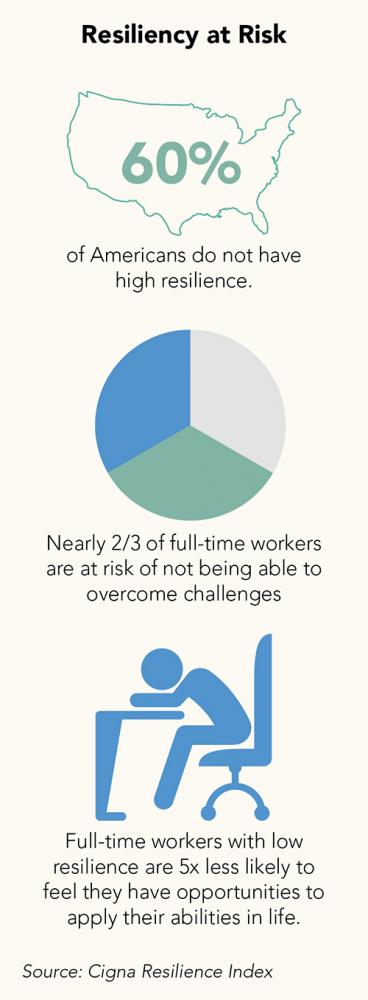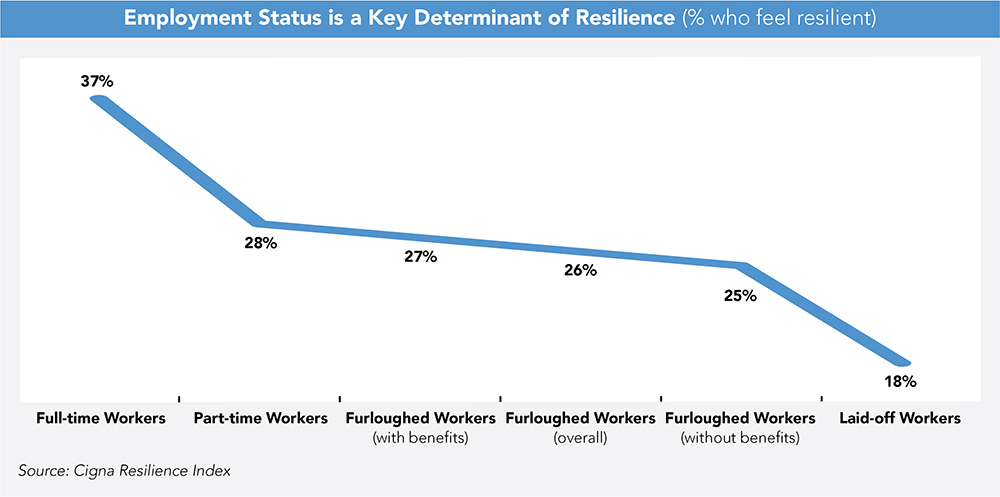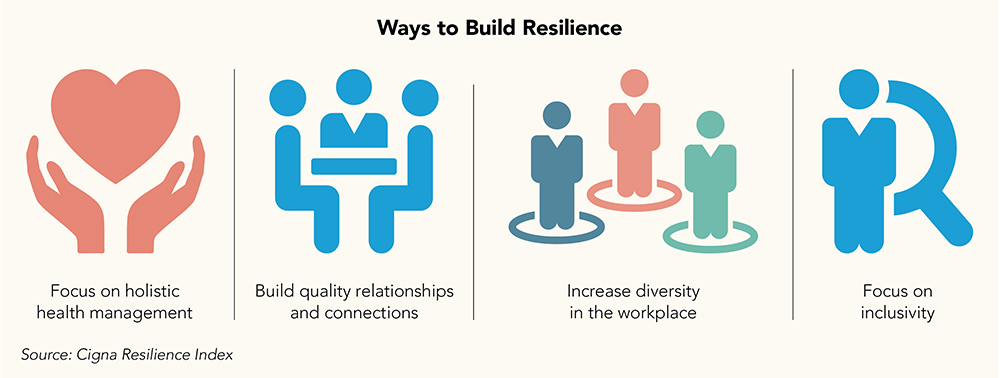
(Please join us for Resiliency in the Age of COVID-19 on February 18th with Dr. Stuart Lustig, National Medical Director for CIGNA, as we discuss how employees are feeling challenged and what businesses can do to help. Click here to sign up https://www.businessnhmagazine.com/events/resiliency-in-the-age-of-covid-19.)
Monica Zulauf has spent her career helping at-risk families manage crises. Her latest role is as development director for The Mayhew Program, which helps at-risk boys in NH. In short, she is no stranger to adversity.
But she says bouncing back has proved a greater challenge during the pandemic. “I have been riding the coronacoaster,” she says. “On bad days, when the coronacoaster is not working so well for me, I cut back on my news. I try to go back to my Mr. Rogers roots and look for the good. Some days it’s hard to do.”
Zulauf misses and worries about her three grown children, two of whom are frontline health care workers, and she misses playing with her granddaughter. She says there is increased demand for nonprofit services, and competition for resources is high, which makes her job of raising money for the organization that much tougher. There are days she asks herself, “Am I upbeat enough to talk to donors?”
Zulauf says colder temperatures have meant no longer visiting with friends outdoors. What keeps her going is the boys and young men served by the nonprofit and their very real daily struggles. “My needs are met. From so many years in the trenches, I know how bad it can be in some of those households,” Zulauf says. “I know how razor thin that margin is for families.”
She keeps her days structured, reaches out to family and friends on Zoom, plays with her dog and relishes having a newly retired husband at home. And, when none of that works, she says there’s chocolate.
Zulauf is not alone. A study released in September by Cigna found resilience—the ability to quickly recover from challenges—is at risk for the majority of Americans.
 Between COVID-19, the economic downturn, increased political divisiveness and a greater awareness of systemic racism, American workers have reached their limit, the study finds. As a result, 60% of the 5,000 workers that Cigna surveyed nationally say they are at risk of being unable to overcome challenges.
Between COVID-19, the economic downturn, increased political divisiveness and a greater awareness of systemic racism, American workers have reached their limit, the study finds. As a result, 60% of the 5,000 workers that Cigna surveyed nationally say they are at risk of being unable to overcome challenges.
The Cigna Resilience Index shows workers are feeling overwhelmed on a number of fronts: 34% feel pessimistic about their company’s ability to endure COVID-19; 84% of black full-time workers are experiencing stress and anxiety about the recent deaths of Black Americans like George Floyd (compared to 66% of Latino, 64% of whites and 54% of Asian workers); and 70% of full-time workers say the economic effect of COVID-19 will be worse than the virus itself.
While it may not be a surprise that those who are unemployed or working part-time have less resilience, even those working full time are finding it tough to rebound with 63% showing only low or moderate resilience.
Isolation is not helping. The report notes one-third of full-time workers and essential workers say they almost never have discussions at work about the psychological effects of COVID on themselves and their families.
While avoiding the subject is harmful, Vincent Corbo, assistant professor of psychology at Southern NH University, warns people to avoid “toxic positivity”—the constant messaging that it’s going to OK without acknowledging the cost. He says we must acknowledge that the pandemic is a stressful event the likes of which we haven’t seen in generations.
Job loss and the fear over job loss continue to wear people down. “At home, close to seven in 10 full-time worker parents (67%) are stressed about figuring out the safest childcare option for their child(ren),” the report states.
The result is a decline in workers overall mental health with four in 10 workers saying that their mental health has been negatively affected by COVID. The pandemic has essentially accelerated burnout.
Corbo says the unpredictability of the pandemic combined with the threats to people’s physical, mental and economic health and the lack of control create a sustained period of stress. “We’re not doing well. We’re not thriving. We’re not pursuing new projects. We are in survival mode,” Corbo says. And people’s self-esteem is taking a hit. “[We] want to think, ‘I am resilient,’ that ‘I am one of the tough people,’” Corbo says. “We don’t recognize the impact this pandemic has had on our collective mental health.”
Why Employers Should Worry
All of this is bad news for employers. Less resilient workers are less likely to enjoy their jobs and more likely to look for a new job within 12 months. They also report lower performance and professional ambition; weaker work relationships; and lower feelings of self-worth and self-esteem.
Without the ability to cope with challenges, workers are more likely to experience stress, anxiety and depression and resort to negative coping strategies, such as social withdrawal and substance abuse, the report states, which is easier to do when working from home.
For employers, that can mean a loss of retention, productivity and workplace culture, which the Cigna study notes are “the tenets that allow a company to operate smoothly and successfully.”
Managers can, however, work harder at spotting the signs that someone isn’t doing well, even though that can be challenging when so many are working remotely.

What Employers Can Do
There are steps employers can take. Key among them is increasing workplace diversity, providing a sense of purpose, proactively communicating with employees and ensuring the work environment is positive, the Cigna report states.
Resilience isn’t just about the ability to bounce back from challenges but also about “deciding which resources we use, when we use them and how we use them,” says Dr. Stuart Lustig, a psychiatrist and national medical executive for behavioral health at Cigna. The Cigna survey found employees receiving regular communications from their employers about the state of the business and those having frequent conversations about systemic racism are more likely to have high resilience. And, workers who feel supported as caregivers while working from home due to COVID-19 are also more resilient, the report finds.
 Other strategies include:
Other strategies include:
• Keep communication flowing both ways. Create an environment where employees “feel comfortable telling their manager, ‘I can get work done but I can’t make the 12 o’clock meeting because that’s when I check in with my kid who is homeschooling,’” Lustig says. “The way we worked before is difficult to do now. Give people as much control in the workplace as possible. When you feel you have more control, the less stressed you feel.”
Employers can decrease unpredictability with increased communication and lay out plans ahead of time, Corbo says.
Managers must identify what they want from employees versus what they need, Corbo says, realizing that at times employees may only be capable of delivering what is necessary until they can build up their resiliency. People must be able to recognize when they need a break and understand that it’s okay to take one when they need to, Corbo says.
• Let employees know what resources and tools, such as employee resource groups, assistance programs, therapists through health insurance, and paid parental leave, are available. “It is important to destigmatize seeking professional help. We need to recognize if we have high blood pressure you see a cardiologist. If you have mental health issues, you see a psychologist or counselor,” Corbo says, adding there is no one way to cope with pandemic stress.
• Make sure employees have many different communication tools, including chat features and video calls. Corbo says employees and employers need to be cognizant of “Zoom fatigue,” as people must scour different faces throughout a call trying to pick up on social cues and expressions. “It’s tiring,” he says.
Lustig says companies need to be aware of how many meetings are held on Zoom and determine whether a conversation can instead be handled with a quick phone call.
• Keep or develop wellness programs that promote mental and physical health, stress reduction and work-life balance. Daily exercise and stress-reduction activities create higher resiliency. Workers who spend time with extended family every day and get the right amount of “me time” are also more likely to be resilient. Employees who work from home (either due to or prior to COVID-19) are also more likely to have high resilience, according to the Cigna report.
• Encourage social connectivity between employees and reward support at work.
• Create and promote a workplace where diversity is the standard as it is connected to higher resilience.
• Create an inclusive workplace community. Employees with shared goals have a stronger sense of camaraderie, friendship and inclusion at work. Lustig says creating such an environment allows people to “be more authentically themselves and have more meaningful conversations in the workplace,” and that allows them to more easily ask for help when they need it. “It’s a sign of strength to ask for help,” Lustig says.

Corbo warns the pandemic is the earthquake, but people need to be wary of the tsunami of mental complaints that will follow in 2021. “This is a good time to reassess our priorities and the metrics we use to measure our life success and our productivity as an employee,” Corbo says. ”That will bring us a renewed sense of control.”
Lustig says it is important that employees and their managers continue to keep communicating what they need to succeed during this difficult time. “When you can say, ‘I need some help,’ you are able to automatically identify where you are and [that] it’s ok to reach out and get the help you need,” he says. “You are at peace with who you are at that moment.”
Learn how to identify employees suffering from anxiety, and strategies to help them cope with the stresses of COVID-19 at "Resiliency in the Age of COVID-19" on February 18 from 11 a.m. to 12:15 p.m.
Featuring a keynote address by Dr. Stuart Lustig, a Q&A with Dr. Lustig and breakout discussion groups. Click here for more information, or to register.

 Current Issue - April 2024
Current Issue - April 2024